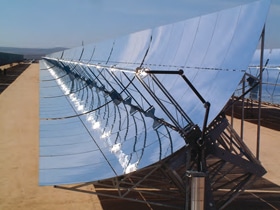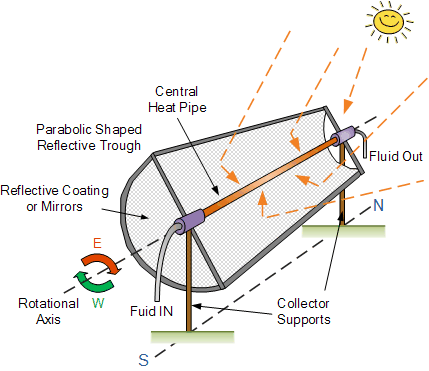
Parabolic Trough Reflector
A Parabolic Trough Reflector Increases the Suns Energy
![]() Thus far we have seen a number of different types of solar collector designs that use the energy of the sun to heat water. Each design whether a basic blackened flat panel collector or a more advanced evacuated tube collector all have their own advantages and disadvantages and for the majority of domestic solar hot water systems, these types of solar collectors are more than adequate. But in order to generate higher temperatures with good efficiency a solar collector in the form of a parabolic trough reflector maybe required.
Thus far we have seen a number of different types of solar collector designs that use the energy of the sun to heat water. Each design whether a basic blackened flat panel collector or a more advanced evacuated tube collector all have their own advantages and disadvantages and for the majority of domestic solar hot water systems, these types of solar collectors are more than adequate. But in order to generate higher temperatures with good efficiency a solar collector in the form of a parabolic trough reflector maybe required.

The parabolic trough reflector is a solar thermal energy collector designed to capture the sun’s direct solar radiation over a large surface area and focus, or more generally “concentrate it” onto a small focal point area increasing the solar energy received by more than a factor of two which means more overall heat per square meter of trough.
The shape of concentrating solar collectors must be specifically designed so that all the incoming sunlight reflects off the surface of the collector and arrives at the same focal point no matter what part of the collector the sunlight hits first.
Concentrating solar collectors for residential applications are usually a “U-shaped” parabolic trough (hence their name) that concentrates the sun’s energy on an absorber heat tube called a receiver that is positioned along the focal point axis of the reflective trough.

Parabolic Trough Reflectors or PTR, are made by simply bending a sheet of reflective or highly polished material into a parabolic shape called a parabola. Since solar light waves essentially travel parallel to each other, this type of solar collector can be pointed directly into the sun and still achieve a total focal output from all parts of the trough shaped reflector as shown.
The parabolic trough reflector when used as a solar thermal energy collector is constructed as a long parabolic reflecting mirror which is usually painted a reflective silver, or made from polished aluminium, or uses mirrors which extends linearly into the trough shape. A metal black heat tube inside a sealed glass tube which can also be evacuated is used to reduce heat losses. The heat tube contains a heat-transfer fluid which is pumped around a loop within the tube absorbing the heat as it pass through.
The parabolic trough reflector can generate much high temperatures more efficiently than a single flat plate collector, since the absorber surface area is much smaller. The heat transfer fluid which is usually a mixture of water and other additive’s or thermal oil, is pumped through the tube and absorbs the solar heat reaching temperatures of over 200oC.
The hot water is sent to a standard heat exchanger design where it directly heats a hot water storage tank for use in the home making this type of solar hot water application a closed-loop active system. However, parabolic trough reflectors use only direct solar radiation to heat the receiver tube as diffused solar radiation cannot be focused onto the absorber making them less effective when the skies are cloudy or the sun is out of alignment.
Typical Trough Reflector Design

To overcome this problem, most concentrating collectors require some form of mechanical equipment that constantly orients the collectors towards the sun keeping the heat pipe absorber at the correct focal point. This can be achieved by using a Tracking Solar Concentrator that aligns the trough with the sun throughout the day, maximising the solar heat gain.
The collector generally has a single rotation axis along the length of the trough which can be orientated in an east-to-west direction, tracking the sun from north to south, or orientated in a north-to-south direction and tracking the sun from east to west.
Parabolic troughs are generally aligned on a north-to-south axis, and are rotated to track the sun as it moves across the sky each day from morning to night.
The advantages of this type of tracking mode is that very little collector adjustment is required during the day resulting in the solar trough always facing the sun at noon time, but the collector performance early in the morning or late in the afternoon is greatly reduced due to the large incidence angles of the trough.
Even though solar trough collectors use tracking systems to keep them facing the sun, they are most effective in sunnier climates where there are good solar resources. Like many other solar collectors, parabolic trough reflectors are modular, meaning that the individual troughs can be connected together.
The advantage here is that connecting them together creates a larger surface area of absorber producing large amounts of solar hot water than can be created by an individual trough. Many single troughs connected together form a collector field were they are connected together in series and parallel rows.
As line-focused concentrating collectors, parabolic trough reflectors are more efficient for industrial and commercial applications that require large amounts of hot water around the clock. In these types of installations, the solar energy trapped by the solar troughs heats a special type of thermal oil to very high temperatures.
The oil circulating around a closed loop active system is used to heat high volumes of water or to generate steam at very high temperatures of up to 400oC which can then be used to generate electricity. Also connecting together parabolic troughs to form collector fields requires large areas of land for the installation, yet they offset the need for conventional energy and provide energy savings and environmental benefits.
Solar concentrators such as parabolic troughs, have a small absorber area and therefore smaller heat losses and provide high efficiencies of around 12% at much higher working temperatures compared to standard flat panel collectors. However, they have the disadvantage of having a smaller angle of view, and therefore, require some form of tracking system or manual adjustment to keep them at the correct focal point.
Also parabolic trough reflectors can not collect most of the diffused solar radiation. Parabolic collectors are not recommended for domestic household use due to their size and high water temperatures, but are desirable for certain industrial and commercial needs to provide large amounts of hot water and/or for producing electricity by running steam turbines.
In the next tutorial about Solar Heating we will look at another type of solar collector which is designed to concentrate the received solar radiation even more into a single focal point while at the same time accept most of the diffuse radiation improving their efficiency.
Furthermore, these concentrators can be stationary or only need small seasonal tilt adjustments to keep their heat pipe within the correct focal point. These types of solar thermal collectors are called Solar Dish Collectors which can be used to focus the sun’s energy onto a single point.











I am interested in building at least on if not a small series of these to generate hot water for domestic use and possibly tie into my hydronic heating system but have found little info on real test numbers as to what to expect for output temps, highs and lows, in a cold climate. Heat expansion requirements, Tube/ pipe materials, build specs, etc. If there is any of this info out there please let me know where to find it! Thanks!
Thanks.
Any one interested in building 100MW of these?
debremarkos
what we do to reduce heat losses because of air around the tube!?
Insulate it.
We use an evacuated glass tube [vaccum] around the central heat pipe.. Due to this convection losses are reduced as there is no air to transfer heat. And glass prevents the radiation to escape through it.. Green house effect..
I hope this helps.
Hi,
Is it possible to buy a small parabolic trough for domestic purposes?
We (AJINOMOTO Company) need to make steam 20bar (10-20 t/hr) then feed to Low-Pressure Steam Turbine as Electric capacity 100-200 KW
This site really has all the info I wanted concerning this subject of dish collector and didn’t know who to ask.